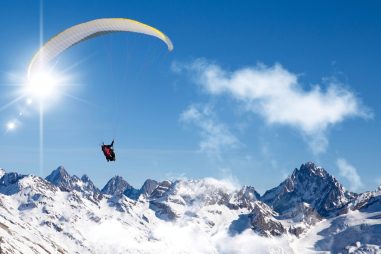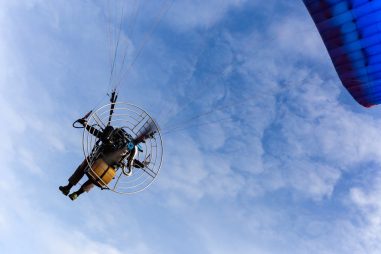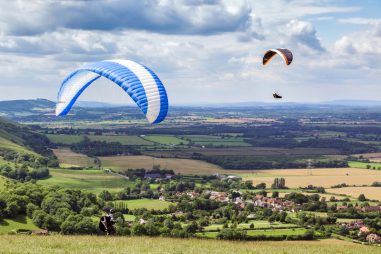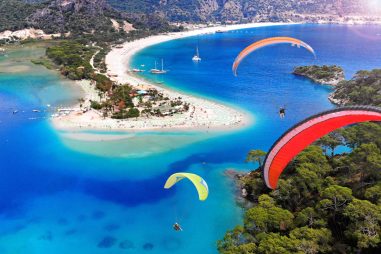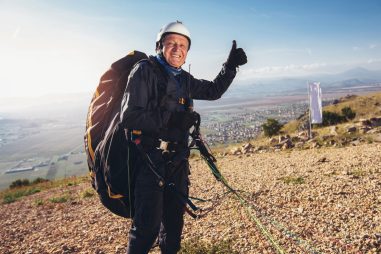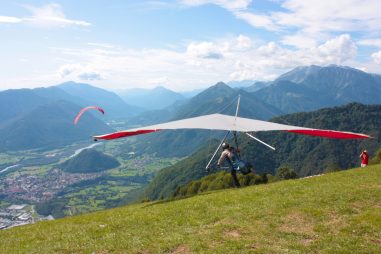There is no age limit in paragliding in the United States, and anyone below 18 years old may join a tandem flight with permission. Paragliding has also become a beloved sport for people with disability. On the other hand, pregnant or those with heart conditions, asthma, or similar may not be allowed to paraglide because of safety concerns.
Is It Legal to Paraglide Anywhere?
No, it is not legal to paraglide anywhere. Although there are a lot of good potential paragliding spots, some, if not most, would require special permission or are strictly prohibited. Here is a quick rundown of these places.
- Residential areas: Some neighborhood areas may require special permission before you can paraglide. Most of them only have recommended hours to avoid disturbing the locals.
- Highly populated city: It is prohibited to paraglide in dense cities and in places where there are tall buildings.
- Highway: Flying on roadways or dense public roads is prohibited to avoid the risk of endangerment during an emergency.
- Plane runway: You may need special permission to fly a glider on a runway based on your location. International or huge runways are prohibited.
- National park: The law states that no ultralight vehicles, including paragliders, have no clearance to fly through national parks.
- Public park: Some cities and states may not allow you to paraglide in public parks, but it varies. Before you go, check with authority and obtain the necessary permits.
- Private land: You can only paraglide on privately-owned land if you have permission from the owner.
- Controlled airspace: Consists of classes A to G, with A as the most restrictive. Classes E–G is considered uncontrolled airspace, where flying a paraglider is possible.
Part of your responsibility is to ensure that your location for takeoff, landing, and flight path are within regulations. Unable to commit to these will affect you and other paraglider pilots because of additional restrictions the USHPA or local authorities may add.
What Airspace Can Paragliders Fly in?
Paragliders can fly in within classes E to G airspace. The airspace consists of six classifications, classes A to G. E and G are considered uncontrolled airspace. Anything above class E is considered more restrictive, with class A being the highest.
- Class A: Starting 18,000 feet (5,000 meters) to 60,000 feet (18,000 meters) above sea level. The most restrictive class. It is for military jets or approved commercial airlines only.
- Class B: Starting 10,000 feet (3,000 meters) until Class A. It is considered the busiest airspace due to commercial airports.
- Class C: Located from the surface to 4,000 feet (1,200 meters). Not as busy as class B, but this is also mainly for commercial airports that don’t have clearance for higher airspace.
- Class D: Airspace from surface to 2,500 feet (762 meters). It is usually for smaller local airports.
- Class E: There are no defined limits for class E. It can go up to 18,000 feet (5,000 meters) based on region. It is why it is the largest of all classes. No clearance is required to access this airspace.
- Class G: This is considered uncontrolled airspace and makes up the area that is not within other classes. ATC has no authority in this area, but pilots must follow the VFR (visual flight rules).
You can access classes E and G when paragliding. Also, during your training, you will receive instructions on any restrictions within each airspace.
Can You Paraglide Over a City?
The answer depends on where you’re based. For instance, in the United States, the FAA prohibits flying over highly dense areas. In Europe, on the other hand, most cities allow you to paraglide. So the best thing to do is check the current policy on the location of your choice.
Consider the takeoff, landing, and flight path before flying with your glider. You want to ensure you don’t break any rules that may jeopardize the entire paragliding community within the area.
Why Are Paragliders Illegal Somewhere?
One of the reasons why paragliding may be illegal in some places is because they are private or government-owned land. This restriction is not only applicable to paragliding enthusiasts but to the public in general.
In some places, paragliders are illegal because of repeated breaking of rules. For example, it usually happens if you fly over neighborhoods or residential areas. In others, it is simply because it’s dangerous to fly over the location or may cause danger to others.
Where Can You Legally Fly a Paraglider?
One example is high elevation areas exclusively for flying. There are several places like this around the world so you will have plenty of experience. Note that each location is different and may require more skill and flying hours than others. Some require you to obtain a higher certificate to fly in more challenging spots.
Best locations for the best paragliding experience:
- Sun Valley, Idaho: This place is great in the warmer season, perfect for long flights. It’s known for snow-dust-filled mountain views.
- Interlaken, Switzerland: It has a glorious view of the Swiss Alps, making it one of the favorites among paragliding enthusiasts.
- Hatcher Pass, Alaska: Best to paraglide during the warmer season and offers a fantastic view of the Talkeetna Mountains.
- Boracay, Philippines: The island itself is stunning. The popularity of paragliding in Boracay is only beginning, so you can enjoy the spectacular view of its clear blue waters all to yourself.
- Annecy, France: You can paraglide in this location all year round. There are various paragliding schools available if you wish to start there.
- Makapu’u Cliffs, Hawaii: This is a paraglider’s heaven. Its constant good wind conditions make it a favorite for distance paragliding.
- Annapurna, Nepal: The weather condition in Annapurna is excellent throughout the year, making it one of the best locations for paragliding.
- Reykjavik, Iceland: If you are a true nature lover, you’d want to visit Reykjavik to witness its landscapes. There are a lot of takeoff locations in this place based on the weather conditions.
- Lima, Peru: The Miraflores Cliffs are among the favorite locations of paragliding enthusiasts. The cliffs offer a magnificent view of the city and its natural landscape.
- Bali, Indonesia: May to October is considered the best month for paragliding in Bali. It is also a perfect place for beginners.
Paragliding is not limited to the United States and Europe. There is a growing community in Asia and South America, and for a good reason.
What Is the Restricted Height for Paragliding?
The restricted height for paragliding is anything above 18,000 feet (approximately 5,000 meters) unless you obtain approval to go higher. It varies in location so check before going beyond the class G airspace. Quickly gaining a higher altitude is also impossible because of changing weather conditions.
During the Paragliding World Championship in 2,007, Ewa Wisnierska got caught in a violent storm where she experienced an ascent of 32,000 feet (approximately 9,900 meters). However, she survived and now holds a paragliding record for flying at the highest altitude.
How High Can You Legally Fly a Paraglider?
You can legally fly a paraglider up to 18,000 feet (5,000 meters) from the surface. Flying at this altitude is only possible if weather conditions allow. Remember that they change unexpectedly.
The minimum height of the hill should be around 250 feet (76 meters) for a smoother liftoff experience. You should also be physically able to carry your gear, even before beginning to fly.
How Low Can a Paraglider Legally Fly?
Under the FAA (Federal Aviation Administration) regulations, the lowest a paraglider can fly is 500 feet (152 meters). It applies in highly congested areas, vessels, vehicles, and structures except over water and in sparsely populated areas. This rule also ensures you don’t endanger someone else in an emergency.
If you need an emergency landing, land in an area without hazard to other people or their property. If you fail to follow aviation safety, you will be subject to investigation by the FAA and will receive legal action.
Can You Fly a Paraglider at Night?
The FAA prohibits flying a paraglider at night because of safety concerns. As a pilot, your visibility around the area is crucial. Although you can carry a strobe light with you to help with visibility, you are only allowed to be airborne 30 minutes after sunset.
You can paraglide in the morning as early as 30 minutes before sunrise. Mornings provide good wind conditions and are less populated.
What Do I Need to Fly a Paraglider?
You will need several pieces of equipment with you before you can fly a paraglider. It can be quite an investment, but your safety depends on the quality of equipment you have. These are all essential to maintain security while in the air. Here are some tools you’ll need.
- Paraglider or Wing: This is the most invaluable piece of equipment that helps you fly. They attach to carabiners on your harness. The cost is usually between $3,000 to $6,000.
- Harness: This will act as your seat connected directly to the glider. The cost is usually around $600 to $2,000.
- Helmet: This will act as your head protection in case of a bad landing. The price of a paraglider helmet is between $200 to $400.
- Gloves: This will add comfort to you while paragliding and avoid the risk of frostbite. Because your hands are crucial in controlling your glider, you want to keep it protected. The cost is around $100.
- Boots: These are necessary for landing and protecting your ankles and feet. The cost of paraglider boots is between $200 to $400.
- Flying suit: A suit will keep you protected from changing weather conditions. It is similar to a windbreaker. The cost is around $150.
- Variometer: This will help keep track of your vertical speed, altitude, and current air temperature. The cost is usually around $150.
- GPS: This will help you keep track of your direction. You can buy a GPS with a variometer. The price is around $250.
- Radio: This is your form of communication with other pilots. It will help you receive information on current weather conditions, clearance before landing, and any emergency.
- Reserve parachute: This acts as another layer of safety in case of a glider failure. The cost is around $800 to $1,500.
- Flight Deck /Backpack: You can put your small pieces of equipment here when you need to set them aside. The price is around $250.
Additional tools you may include as you get more experience are GoPro to take photos and videos of your flight, a phone as a backup to your radio, and sunglasses to help with visibility. Unfortunately, it’s inadvisable to buy secondhand equipment to avoid the risk of emergency while in the air.
Do You Need Permission to Paraglide?
You need permission to paraglide in some locations. For instance, you may need to contact local authorities to fly over private land or a public park. In other cases, you may need higher flying hours before you can fly to a more challenging location.
Although there are accessible locations for paragliding doesn’t mean you can fly anywhere. To be a more responsible pilot, check with your local authority or the owner of private land before deciding to include it in your flight path.
Do You Have to Have a License to Fly a Paraglider?
You don’t need a license to fly a paraglider. It is because the FAA classifies a glider as an ultralight vehicle. However, you must undergo training and follow the law covering where, when, and how you should fly. In addition, you must be responsible and govern yourself for the sake of the entire community.
If you want to enhance your paragliding experience even further, you can get a sports pilot’s license. You can do tandem flights and explore more challenging locations. This license is FAA’s seal of approval that your skill and knowledge are top-notch.
Can You Fly a Paraglider Without a License?
You can fly a paraglider without a license. However, you must receive certification that you can get by enrolling in a paragliding school. In addition, your paraglider must pass a series of tests conducted by the FAA to measure factors such as stability, control, and performance.
Here are the FAA’s requirements before flying a paraglider:
- You must have a minimum of 20 hours of solo flight time. You can get this by enrolling in a paragliding school.
- Only one person can use the paraglider. You’ll need a license to do a tandem flight.
- You must have a minimum of 30 flying days.
- You must receive certification either from USHPA or any recognized aviation organization.
- You must have a total of at least 90 flights.
- Your top speed must be 55 knots (63 mph / 101 kph).
- Your weight, including the vehicle, is less than 254 pounds (115 kg).
Paragliding is a group-regulated sport, and it is not compulsory by law to be a licensed pilot. On the other hand, certification is necessary for the United States, while it may differ in other countries.
What License Do You Need to Paraglide?
You don’t need to have a license to paraglide. However, you need a sports pilot’s license if you wish to do a tandem flight or become an instructor. Receiving this license comes with greater responsibility. It is also the aviation organization’s approval that you have the skills and experience.
A sports pilot’s license allows you to fly vehicles above the ultralight classification, also called the light-sport aircraft. You will have greater freedom to paraglide on locations that don’t meet the standard ultralight classification.
Do You Need a Pilot License to Fly a Paraglider?
No, unless you wish to be a tandem flight instructor or do tandem flights in general. Once you have a sports pilot’s license, different rules will apply to you, and you can fly in locations that don’t fit the ultralight vehicle category.
You will be able to fly under the light sport aircraft category. Keep in mind that this is not a license per se but otherwise a certification or FAA’s way of recognizing your level of experience and knowledge.
How to Get a Paragliding License
You don’t need a license to paraglide, but you can be a paraglider pilot. Conversely, you must obey rules set by the Federal Aviation Administration. Here is a list of ways be a paraglider pilot:
- Enroll in a USHPA or EHPU certified paragliding school.
- The most effective way to learn is to take flying lessons. You need 90 days of total flight and 20 hours of solo flight time before you can officially fly on your own.
- Learn aerodynamics and weather conditions in paragliding. It will help you make wise decisions while in the air.
- Buy the pieces of equipment you need to fly a paraglider. Buying secondhand items is unwise.
- Join paragliding clubs to get advice on when and where to fly and to learn from their experience.
- Learn the language or the jargon pilots use. It will be helpful when you are on air and receive instructions through your radio.
To continue further and receive a sports pilot’s license, you’ll need:
- Pass the medical exam issued by a doctor.
- Have a valid driver’s license.
- Have shown to have the skills, ability, and experience in paragliding through practical and knowledge tests.
Because the FAA is lax in licensing policies, you must be a reliable and competent pilot. The FAA follows a thorough investigation for any complaint and performs legal action as necessary.
How Long Does It Take to Get a Paragliding License?
You don’t need a paragliding license to fly, but if you wish to be a basic and tandem flight instructor, you’ll need to have a minimum of 200 flying days and 300 flights and have an advanced rating. You can get a license within a few weeks as soon as you meet their requirements.
Experience requirements to be an instructor:
- Basic instructors must have an intermediate rating, with a minimum of 200 flying days and 300 flights, plus a medical certificate from an accredited clinic.
- Tandem instructors must have an advanced rating and a minimum of 200 hours of air time, or 100 hours with 500 flights of at least 500 feet (152 meters) vertical descent or flights of 2 minutes or longer.
- Have a First Aid and CPR completion card accredited by Red Cross or American Heart Association.
- Complete a Fundamentals of Instructing test administered by USHPA.
- Complete an instructor training seminar, evaluation, and instructor exam.
Meanwhile, it only takes nine days of training to be able to fly a paraglider. Longer if necessary. To receive a P2 rating, a rating where you can paraglide on your own, you need to have at least 35 flights which you can accomplish easily while on a paragliding school.
Do You Need a Certificate to Paraglide?
Yes, you need a certificate to fly a paraglider. To receive basic certification, an accredited aviation organization inspects the stability of your equipment. The USHPA also developed a rating system to track your progress. There are various levels of certification, with P1 being the lowest, a rating for beginners.
Rating program/certification to paraglide:
- P1: This is for beginner pilots who are not yet ready to fly independently but can take off, fly straight, and land.
- P2: This is for novice pilots who can maneuver better and fly solo. It signifies that you understand air movement, weather conditions, meteorology, and aerodynamics.
- P3: This is for an intermediate pilot who gained further experience and flight skills. You have demonstrated to have good decision-making and focus on refining your ability.
- P4: This is a rating for an advanced pilot. You are a mentor and a role model to less-experienced pilots and can apply for an instructor license to teach the next generation of paragliders.
- P5: This rating is for a master pilot. You have demonstrated impeccable flying skills over a long period. You have flown to several locations and can maneuver a broad range of gliders. You receive endorsement from others to gain this rating.
The certification, including these ratings, is issued by an appointed USHPA official. Your rating is more than just a merit badge because it allows you to fly outside your area and to more challenging locations.
What Certification Do You Need to Paraglide?
You can paraglide with a rating or certification of P1 or beginner pilot. You still won’t be able to fly solo, but you’ll have plenty of opportunities to paraglide with supervision. You will also require certification from a representative of the USPHA stating that your pieces of equipment are safe and stable. To paraglide solo, you need to reach a rating of P2 for a novice pilot.
The higher your rating/certification, the more responsibility you have as a paraglider pilot. Part of your commitment is to obey rules set by the USHPA to ensure everyone’s safety.
How Do I Become a Certified Paraglider?
You can become a certified paraglider when you meet the requirements listed by the USHPA or EHPU. It involves receiving certification of your equipment and demonstrating that you have enough skill and experience. Here is a list of what you can do to help you be certified:
- Enroll in a USHPA- or EHPU-accredited paragliding school.
- Learn handling techniques and safety, and gain flying experience.
- Learn in the classroom the introductions to aerodynamics, weather, FAA regulations and airspace, and safety protocols.
- Buy equipment to further your flying experience. It must be stable and follows safety as per USHPA guidelines.
Once you have all of these, you are ready to take an exam administered by an aviation representative. You must demonstrate that you have the knowledge and skills to fly solo.
How Long Does It Take to Get Certified in Paragliding?
It takes up to nine days to two weeks of training before you receive your USHPA P1 Beginner certification. It depends wholly on your learning momentum and the weather conditions. You can continue to gain more flying experience after receiving your beginner certificate.
P2, or novice, is the rating where you can fly your paraglider solo. To achieve this, you must have more flying experience and a better understanding of aerodynamics, weather conditions, and FAA regulations.
Can You Paraglide by Yourself?
Yes, you can paraglide by yourself. You need to have a rating or a certification of P2 or novice pilot from the USHPA. You should be able to demonstrate the following to receive a novice rating.
- Minimum of 35 flights in total.
- Logged seven flying days.
- Have a minimum of 8 hours of paragliding school.
- Has a flight plan with obstacles to stay clear of and areas to avoid.
- Reliable analysis of site conditions and pieces of equipment.
- Has controlled takeoff, flight path, and landing.
- Explains the right of way traffic rules.
- Have an understanding of meteorology, aerodynamics, and weather conditions.
- Must pass the USHPA Novice Paragliding written exam.
- Agreed to provisions of USHPA waiver and assumption of risk for the novice rating.
It takes about two to four weeks of training and flying experience before you can paraglide alone. After that, your instructor will decide when you are ready to take your first solo flight.
How Old Do You Have to Be to Solo Paraglide?
In the United States, you must be at least 18 years of age before you can fly on your own. In Europe, the minimum age to fly solo is 16 years old. Anyone younger must receive permission to do a tandem flight.
The minimum age for solo paragliding is not likely to change anytime soon. Even so, no matter the age, even in tandem flight, the participant or the pilot must receive training for flying to be safe, successful, and fun.
Can Kids Go Paragliding?
Yes, kids can go paragliding! You will see kids as young as four years old go on a tandem flight with their parents. They are obviously not allowed to solo fly unless they are 18 in the United States or 16 in Europe. But with permission, and depending on the country, there is no age limit to do a tandem flight with a more experienced pilot.
Kids may be required to take a short training before going on a tandem flight. It is a way to maintain everyone’s safety and, of course, to make the experience safe and fun!
Can a 10-Year-Old Paraglide?
Yes, a 10-year-old can paraglide. Although, it may depend on your location. Countries such as Brazil and Barbados require children to be at least 14 years old to participate in a tandem flight. Conversely, there is no age limit in the United States and Canada.
Part of your responsibility as a pilot is to check the current policies around the minimum age in your area before bringing children on a tandem flight. You may also need to get additional permission. But, again, this is for everyone’s security.
Can Minors Go Paragliding?
Yes, minors can go paragliding. They can join a tandem flight with a more experienced pilot. They will receive training for safety measures and an overall successful experience. Many of the best paraglider pilots started paragliding when they were young.
Interestingly, Corfu, an island in Greece, is the only location so far that requires a minimum age of 18 before they can join a tandem flight or fly solo. On the other hand, you can paraglide as a minor anywhere else with an experienced pilot, provided you have permission.
Does Paragliding Have an Age Limit?
Amazingly, there is no age limit in paragliding! You will see retired seniors on a tandem flight, having the time of their lives. However, they must be in good physical condition. Here are a few things to consider before paragliding.
- There is a weight limit in paragliding. If you’re a passenger in a tandem flight, the weight limit is usually around 200 to 260 pounds (100 to 120 kilograms).
- Unfortunately, you cannot fly if you are pregnant or have health problems such as asthma, heart disease, or others.
- Have received sufficient training on safety measures.
The aviation organization may set an age limit in cases of aerial competition, but it varies per location. As a passenger, you need to make sure you can handle the weight and running involved in flying a paraglider.
How Old Do You Have to Be to Paraglide?
In the United States, there is no age limit to try paragliding. Anyone below 18 years old may join a tandem flight provided they have permission. In other countries, for instance, Iceland, you must at least be 14 years old. Wherever you are, check the current policy in your area before attempting to paraglide with a minor.
Countries with no age limit:
- United States
- Canada
- New Zealand
- Austria
- Colombia
- Ecuador
- Japan
- Norway
- Switzerland
- South Africa
- Thailand
- United Kingdom
- Vietnam
You must attend a session or several sessions to understand safety measures before attempting to join a tandem flight. You or a guardian must also sign a waiver and obtain permission to fly together.
How Old Do You Have to Be to Go Paragliding With Someone?
The answer differs per country and city. For example, there is no age limit to join a tandem flight in the United States, but a country like Spain, for instance, requires you to be at least 12 years of age. Below is a breakdown to see the difference in the age requirement for each country.
Countries with an age limit between 3 to 14 years old:
- Australia (14 years old)
- Brazil (14 years old)
- Egypt (12 years old)
- Indonesia (10 years old)
- India (10 years old)
- Greece (7 years old)
- Qatar (5 years old)
- Poland (4 years old)
- Turkey (4 years old)
- Tunisia (3 years old)
Not only is the age limit different per country but also per city. For instance, Greece has a minimum age limit of 7 years old, except in Corfu, with an age limit of 18.
Can Disabled People Paraglide?
Yes, disabled people can paraglide. Tandem paragliding has made this possible. With an experienced pilot, even the deaf, blind, or those with physical disabilities can fly with assistance. Amazingly, technology continues to provide ways where everyone can experience paragliding. There are already programs available where they can pursue flying solo.
Aviation organizations like Project Airtime specialize in introducing paragliding to disabled people free of charge. This sport is growing to be a form of therapy for them. Just because you’re disabled doesn’t mean you can’t fly.
Can You Paraglide in a Wheelchair?
Yes, you can paraglide in a wheelchair! Those unable to walk have found paragliding to be the perfect activity. A group called Flyability in the UK designed a wheelchair for everyday use and for paragliding. Engineers at the University of Utah continued this and developed a specialized wheelchair.
The newly developed wheelchair allowed instructors to teach these paragliding enthusiasts to become pilots. People with injuries and who are wheelchair-dependent were soon flying solo.
Who Cannot Do Paragliding?
Those with underlying health conditions such as heart disease, asthma, or anything similar cannot paraglide. Unfortunately, even those who are currently pregnant are discouraged. Additionally, paragliders have a maximum weight limit they can carry. As a passenger, you should weigh around 240 to 260 pounds (110 to 120 kilograms).
The purpose of these restrictions is for safety measures. While in the air, there is no immediate access to the ground in case of an emergency. Going beyond the weight limit also adds a risk of glider failure.


